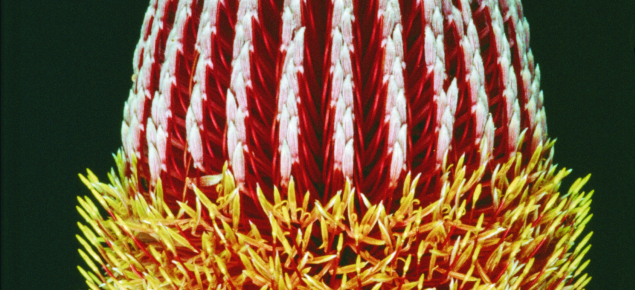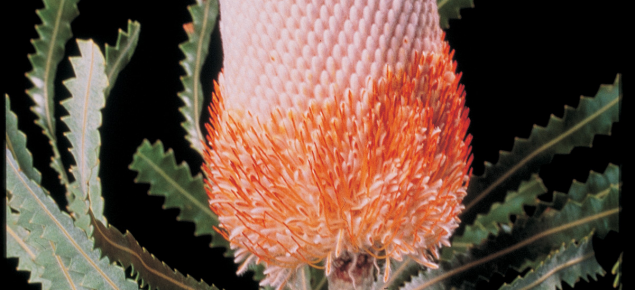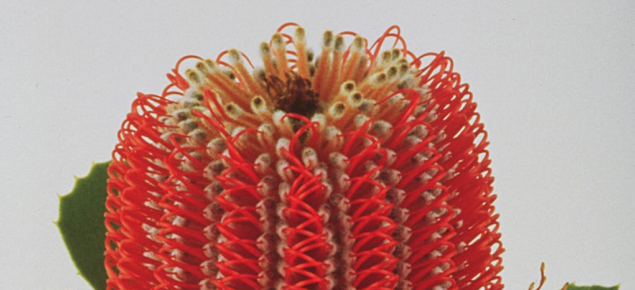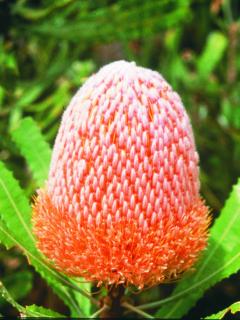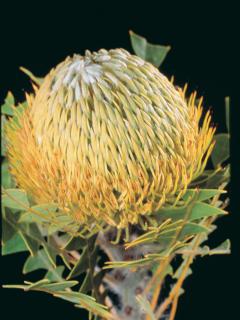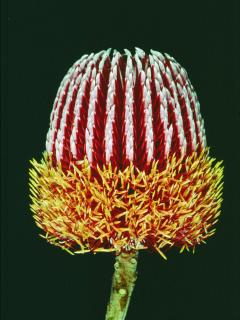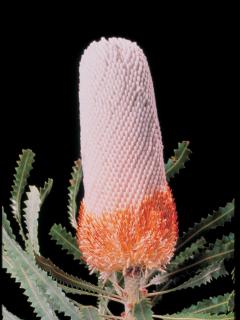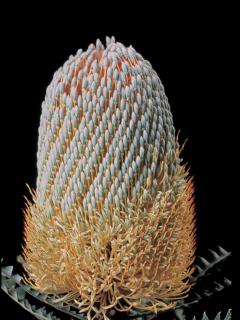Types of banksias
More than 12 species of Western Australian banksias are suited to cutflower production. These include Banksia hookeriana, B. coccinea, B. baxteri, B. prionotes, B. menziesii, B. speciosa, B. burdettii, B. attenuata and B. grandis.
Flowers range in colour from red (B. coccinea) to orange/white (B. prionotes). Depending on their origin, species are suited to different growing regions. For instance, B. coccinea and B. baxteri are best suited to the Albany-South Coast region and may not flower in the north of the state, while B. hookeriana and B. prionotes are more suited to hotter regions north of Perth. B. menziesii grows over a wide range of conditions but is particularly suited to the Perth-Capes area. Likely harvest times are shown in Table 1.
| Species/varieties | Harvest times |
|---|---|
| B. ashbyi | Jun-Dec |
| B. attenuata | Nov-Dec |
| B. baxteri | Sept-July |
| B. burdettii | Jan-Feb |
| B. coccinea | Apr-Nov |
| B. ericifolia | Apr-Sep |
| B. hookeriana | All year |
| B. menziesii | Feb-Oct |
| B. occidentalis | Dec-Apr |
| B. prionotes | Jan-Aug |
| B. sceptrum | Dec-Jan |
| B. seminuda | Apr-May |
| B. speciosa | Oct-Mar |
Banksia cultivation
Banksias grow well in deep, well drained, slightly acidic sands (pH 5.5-6.5), sometimes overlying limestone or gravel lenses. Highly alkaline soils are best avoided for most commercially grown species. Site selection for successful flower production is therefore important.
It is also important to soil test previous cropping land for residual phosphorus as banksias do not tolerate high levels idealy around 20 mg/L. Sites also need to be tested to be free of Phytophthora spp. dieback pathogen. To minimise the risk of introducing or spreading dieback, buy disease-free plants and apply basic quarantine measures. This includes fencing the site, and using foot and vehicle baths to stop soil movement from surrounding areas into the site.
Dieback affects the plant root system killing the crown and has the potential to kill plants at any age. It is also aggravated by poor drainage.
Sites should be free of weeds and control needs to be implemented well before planting.
If there is a requirement to deep rip the rows, do this before cultivating. But before any cultivation is attempted, make sure sufficient moisture is present to prevent wind erosion.
If soils are compacted, deep rip the beds to at least 600mm below the surface. Mound the planting bed where there is an issue with surface drainage. Mounding can also benefit the reduction of water-borne pathogens colonising the plant’s root system, such as Phytophthora and Pythium. This will raise the planting bed above the natural subsurface water flow. Also irrigation water drains more effectively from the root system. However on free draining sites and where no irrigation is applied, mounding should be avoided.
Grower experience indicates that single rows are generally easier to work and manage than double rows. However, some species such as B. coccinea when planted as two rows per bed, appear to give higher production results than those from single rows.
In-row plant spacings are determined by:
- species size at maturity
- irrigation or non-irrigation production
- Mechanical harvesting versus hand picking.
A rough guide for planting design is given for different species in Table 2.
| Species | Intra-plant distances (m) | Between-row distances (m) | Number of rows 1m apart in bed | Plant density (n/ha) |
|---|---|---|---|---|
| B. coccinea | 1-2 | 4 | 1 | 1250-2500 |
| B. coccinea | 1 | 4 | 2 | 2500 |
| B. hookeriana, B baxteri, B. menziesii | 2-3 | 4 | 1 | 833-1250 |
| B. prionotes, B. speciosa | 3-3.5 | 4 | 2 | 1429-1667 |
Planting out
Irrigation layout and mulching should be in place before commencing to plant out. The planting bed should also be thoroughly wetted up.
Banksia seedlings should be planted in late April to early May, or well before the winter impacts on soil temperature (less than 15°C). Alternatively, the seedlings could be planted in mid-spring, coinciding with increasing soil temperatures. Where delays in autumn planting occur, seedlings held over to spring should be re-potted into larger containers to avoid root binding issues.
To plant out without irrigation is possible in certain areas in autumn if there is a good chance of follow up rains to ensure sufficient root development before the summer dry period.
Use of mulches may aid plant establishment and growth, where organic and non-organic mulches can be used. Organic mulches can be well composted woodchips, coarse sawdust, or weed-free straw or cereal stubble. Organic mulches can allow beneficial soil organisms to build up. Some documentary evidence suggests that Phytophthora colonisation around the host root systems is greatly reduced through the development of antagonistic microbial activity under the decomposing straw.
The non-organic mulches consist of either a plastic film of varying micron thicknesses, or a woven plastic fabric known as Weedmat. This is more expensive but lasts three to four times as long as the film. If using plastic film it is important to have a well cultivated planting bed wherethe plastic is to be laid. This will enable the plastic layer attachment to tension the film correctly and eliminate the humps and hollows which develop. When cultivating avoid cultivation of inter-rows as this will reduce stimulating weed germination and diminish the risk of sand blasting and wind erosion as seedlings are established. The plastic film is usually associated with row mounding and/or deep ripping as it can be applied as a one pass operation during the mounding process.
There are a couple of negatives to plastic film:
- The film becomes an environmental hazard when it begins to break down over after a period of time. It will eventually require removal and disposal.
- Some winter irrigation may also be necessary as the plastic will shed some rainfall away from the row plantings.
However the advantage of using film lies with ease of management and application.
Windbreaks are essential for successful banksia establishment. If possible, establish natural windbreaks well before seedlings are planted.
Successful windbreaks are designed to reduce wind speed, which in turn reduces turbulence. Various woven plastic materials can be used to provide permanent wind protection.
Individual plastic tree guards or specialised plastic sleeves can also be used. Some management issues should be considered when using this form of wind protection. Close fitting sleeves or guards can harbour weevils and complicate hand weeding. If the guards remain in place for any length of time, plant growth may be affected. Often a soft spindly growth is produced. The plants then have a tendency to fall over when the guards are removed. Stem twisting and poor branch development will result, necessitating remedial pruning and staking. Using individual wind guards is still a good management choice if other options are not available.
The guards are cost effective and easy to install. However, it is important to use them only for a short period, generally the first six to eight weeks of establishment.
Pruning
Pruning is an important management practice used for cultural improvement and productivity in horticulture and has a number of benefits in:
- improving in yields
- producing of high quality blooms
- extending the commercial life of each bush
- improving plant structure
- disease control
- improving manageability and harvesting.
It is important to observe the growth habit of each species, the flowering period and initiation, and stem length required. All pruning equipment should be disinfected during pruning and prunings disposed of afterwards.
The time of pruning depends on floral season of a species in the region where it is grown. For many banksias flowers for the next year are formed within the stem well before they appear as buds and flowers. For some banksias such as B. coccinea it takes 12 months for flowers to develop while in B. baxteri it takes four months. For most banksias this means pruning as soon as practical after harvest, while flowers are fresh (Table 3).
For B. coccinea the following year’s flowers are initiated towards the end of current year’s flowering in November and should be pruned soon after harvest.
B. menziesii should be pruned after August. However, this may vary and careful observation and research by the grower is required to ascertain performance in any given location.
Table 3 Development stages and pruning time of Banksia species
| Species | Floral inititation | Flowering appearance | Development time (months) | Recommended pruning time |
|---|---|---|---|---|
| B. ashbyi | Nov | Apr-Aug | 8 | Two forms of this selection. Northern form has lignotuber and can be pruned harder than the more southern non-lignotuber form. PRUNE AFTER HARVEST |
| B. baxteri | Sept-Nov | Dec-Mar | 4 | No lignotuber. There is a significant amount of time between completion of one year’s flowering and initiation of next season’s flowers All pruning must be completed BY MID APRIL |
| B. burdettii | Oct-Dec | Jan-Mar | 8 | No lignotuber All pruning must be completed
PRUNE AFTER HARVEST |
| B. coccinea | Nov | Jul-Nov | 12 | No lignotuber The following year’s flowers are initiated towards the end of current year’s flowering. PRUNE AT HARVEST/POST FLOWERING |
| B. hookeriana | Dec-Mar | Apr-Oct | 9 | No lignotuber Floral initiation occurs in early summer. Flowers on two year old shoots
PRUNE AFTER HARVEST |
| B. menziesii | Sep-Nov | Mar-Aug | 8 | Has lignotuber. Can be pruned harder. Floral initiation from September to November.
PRUNE AFTER HARVEST |
| B. prionotes | Oct | Mar-May | 6 | No lignotuber All pruning must be completed
PRUNE AFTER HARVEST |
| B. speciosa | Sep-Oct | Oct-Feb | 12 | No lignotuber Flowering occurs all year round. Peak occurs Oct – Feb PRUNE AT HARVEST/POST FLOWERING |
Irrigation and nutrition
Irrigation
Many banksias in the wild are able to use surface soil moisture and groundwater at depth. They use surface water when it rains and also develop extensive tap roots that can extract water from up to 7 metres to survive dry spells.
On deep sands banksias will require irrigation towards the end of summer if there has not been adequate rain to effect recharge. Restricting water availability during active growth phases and during flowering, particularly if this occurs in summer, will have a direct impact on stem length and bloom quality.
The key to successful water management of banksias is to not over water plants so they become waterlogged, but to provide sufficient water to recharge the profile. Although banksias can tolerate low levels of water supply for prolonged drying periods this will compromise stem and flower production.
A water monitoring tool such as tensiometers will greatly assist in irrigation management of banksias.
(Figure 1).
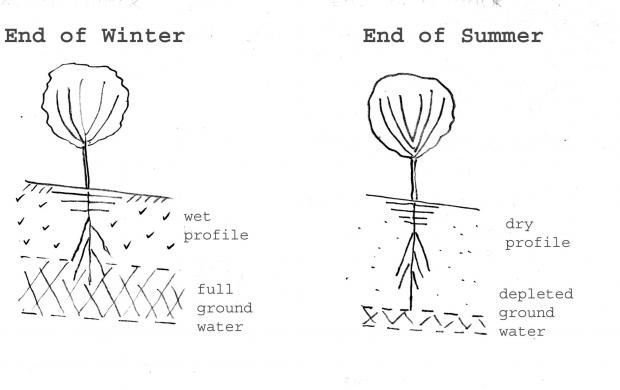
Figure 1. Comparison of water available to mature banksia at the end of winter when the soil profile is completely wet up to the end of summer when the surface layer of soil is dry and most of the deeper ground water has been depleted.
[Text Box: Photograph 1 Young Banksia attenuata plants under irrigation]
At some locations, such as in the south west of WA where ground water remains within a meter of the surface for most of the year, it may be possible to get reasonable production from Banksias by relying entirely on ground water to supply plant needs.
In northern areas by late summer and early autumn surface water and deep ground water in the rooting depth of banksias is almost gone and without rain or irrigation there will be plant losses.
Fertilisers
Although there is limited information on fertiliser requirements, banksias appear to respond well to balanced fertilisers applied at moderate rates. Having a suitable fertiliser program is critical to producing stems of sufficient length, the right thickness and quality flowers. It is essential when designing a fertiliser program to also have efficient irrigation systems delivering adequate water.
Amounts of nutrients required by banksias appear to be considerably less than required by waxflower.
There are two main ways to fertilise banksia plants:
- topdressing solid or granulated fertilisers usually split into several applications a year
- injecting readily soluble fertilisers through irrigation lines.
Dissolved fertilisers are sometimes applied as a foliar spray although this is usually to correct a specific deficiency and is an expensive way to fertilise plants.
The following recipe was found to work for mature banksias but further testing is needed for general application.
In summer make up a stock solution of:
| Urea | 0.83kg |
| Potassium nitrate | 1.76kg |
| Calcium nitrate* or magnesium sulphate | 0.32kg |
| Chelated trace elements | 0.32kg |
In winter (from April to June) only, inject:
| Potassium sulphate | 0.8kg |
| Calcium nitrate* or magnesium sulphate | 2.5kg |
| mono-amonium phosphate | 0.1kg |
| Chelated trace elements | 0.012kg |
* Calcium nitrate or magnesium sulphate can cause precipitation.
Prepare the fertilisers as a 200 litre stock solution and inject 10 litres of this stock solution per 800 plants being watered.
Acclimatise young plantings to the fertiliser program by increasing the frequency of injection gradually. Inject fertilisers one day per week at above rates for first month, then one day every three days for two weeks increasing frequency until plants are fertigated daily.
Note: It is the responsibility of the user to ensure all safety precautions are taken when handling and dispensing fertilisers for the operator and people associated with this process. Fertiliser requirements may vary with the variety of banksia being grown. The recipe described above should be applied to test plants before general use.
Postharvest treatments
To maintain the best quality, banksias should be harvested in the cool of the morning and moved into the packing shed as soon as possible to avoid blooms heating up and dehydrating.
Banksias are preferably picked when no more than 20% of florets open along a bloom. Picking later results in some of older florets drying on the flower, reducing the fresh look. Banksia leaves dry quickly and can’t be readily re-hydrated. Florets are quickly dried if left in the heat for short periods.
This greatly reduces the freshness of flowers and their saleability. To avoid this, banksia stems should be stood in water at the earliest possible stage. Harvesting should be managed to avoid gluts that lead to stems being left in a heap on the packing shed floor.
Galls on leaves are unsightly and these stems should be culled from harvest. Once in the packing shed the lower 15 to 20cm of leaves should be stripped from stems. This can be done using a machine designed for the purpose. Stems are then graded and re-cut to length and stood with stem ends in 10 cm of clean cool water (20ºC). About 50-100 ppm of chlorine in water can be used if necessary.
Banksias do not respond to the floral preservatives of biocides or sugar or require anti-ethylene treatment.
They are generally not bunched but packed and sold as individual stems.
Buckets containing banksias should be moved into a coolroom at 1-4ºC as soon as possible after processing. Stems should be moved to markets rapidly although banksias can be cold-stored.
Banksia prionotes stores well over four weeks provided the blooms were dipped in fungicide and a high humidity storage atmosphere was maintained during storage, such as use of plastic bags. Alternatively, wet newspaper has been used.
The storage life of banksias depends on the quality of flowers, age and species. Before attempting to store large quantities of flowers, test batches commercially. Ideally the cool chain should be maintained to markets.
If banksias are to be sold dry, they should be tied in bunches and hung upside down in the roof of a dry shed to allow quick drying.
Acknowledgement
This article was developed from original work by Kevin Seaton, Bill Woods and Aileen Reid (DAFWA), Gerry Parlevliet and Max Crowhurst, Digby Growns (all previously DAFWA) and the Banksia industry.


